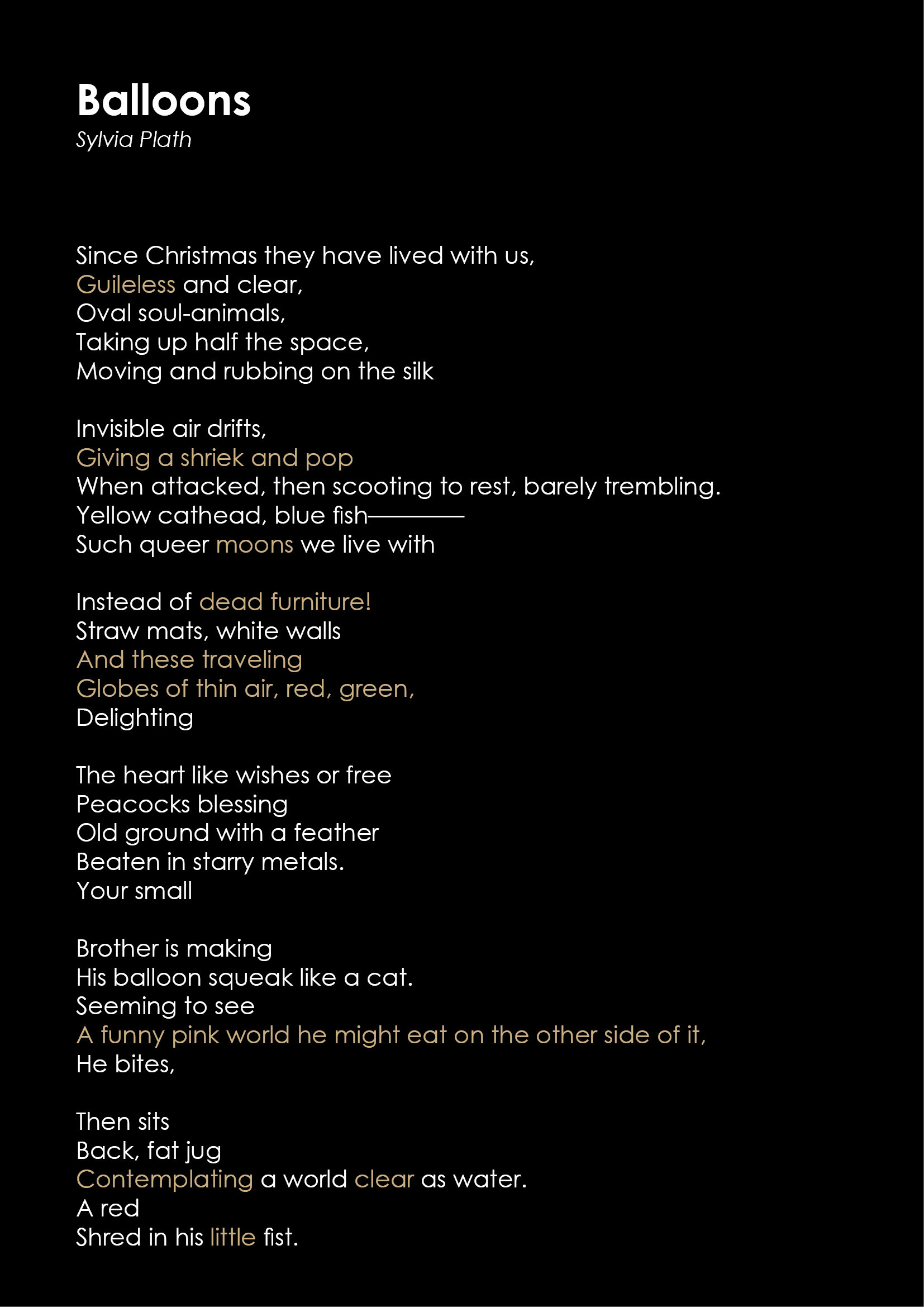Poetry Analysis — Balloons by Sylvia Plath
Sylvia Plath famously had a troubled relationship with her mother Aurelia, and consequently was rather ambivalent towards motherhood. In poems such as “Morning Song”, her poet-speaker is baffled by maternity: she declares herself “no more [the child’s] mother / than [a] cloud … [e]ffac[ed by] the wind”; in “Medusa”, she resents the “old barnacled umbilicus” that binds her to her mother, and eventually assets that “there is nothing between [herself and her mother]”.
Here, in “Balloons”, however, Plath’s poet-speaker speaks joyfully of motherhood. Readers of Paper 3 must recognise that this is one of few poems in Ariel--a collection plagued by chronic misery--that Plath’s poet-speaker is unambiguously happy.
Guileless — personification of the balloons, but perhaps also an apt description of the child.
Giving a shriek and pop —n apt personification: we perhaps cannot help but note the similarity between the sounds produced by the balloons and that of an infant/toddler. Here, Plath's poet-speaker appears to associate her son with his playthings.
Many of the descriptions (and personifications) of the balloons, indeed, are apt descriptions of young children too.
moons —The moon is typically forbidding in English literature: it is a symbol of infertility and distance (see "The Moon and The Yew Tree). Here, however, the moon-balloons are vital--empowered, the language suggests, with agency, to shriek and pop and scoot and "delight the heart".
dead furniture — If the furniture is "dead", the child and his playthings are vivifying
If the initial impression of the balloons --the way in which "they take up half the space, / [and] mov[e] and rub... on the silk"--suggests parasitism, this later characterisation of them as quirky, vivid, animals quickly shows that they are not unwelcome
And these traveling Globes of thin air, red, green — The language used to describe the balloons never directly acknowledge them as balloons: they are described in terms of their traits: "globes", "ovals", or colours. Consider how this might be similar to the way in which a child might see these balloons--not as balloons, but as shapes of colours.
A funny pink world he might eat on the other side of it — The child lacks understanding of the world--and indeed of the concept of balloons (see previous note on how the speaker never acknowledge the balloons as balloons); his innocence is endearing
Contemplating — The child's bafflement at the destruction of the balloon is both entertaining and fascinating for Plath's speaker. The naivety of the child is precious.
Motherhood is perhaps one of the key themes readers of P3 have to engage with. "Balloons" is perhaps apt for comparison with "Nick and the Candlestick", and "You're".
Clear — Clear is repeated twice in this poem. Perhaps unremarkable in other collections or poems--a world/day of clarity is particularly rare for Plath's speaker, whose poetry is typified by its penchant for gloom and death.
The poet-speaker's use of the word "clear" in this poem is particularly striking, in suggesting the joy her child brings into her life. For the poet-speaker, it is not merely from the perspective of the child that the world is clear. In both instance of use, the world is described as objectively clear. The child clarifies her view of the way--redeeming her, almost, from her typical misery.
little — We hardly associate Plath's imagery with cuteness. Here, the child is however cherubian.
Need more help in understanding Language Literature?
Join Afterskool’s Language Literature tuition classes for tips and tricks to master the subject.
Click here to enrol.

